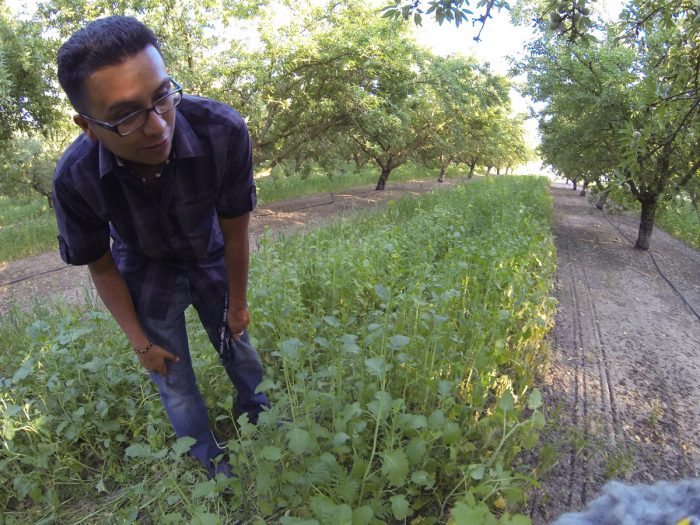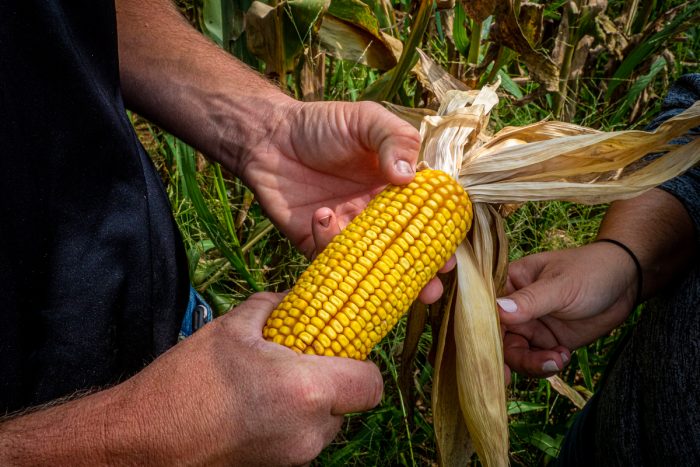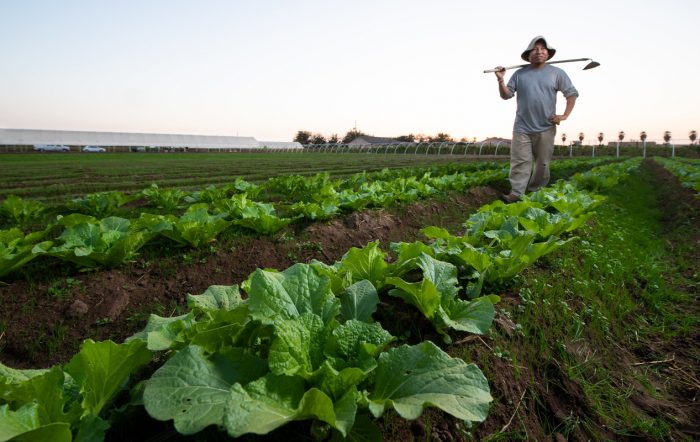Dave McLaughlin’s central Pennsylvania farm has been in his wife’s family for seven generations. Their son now operates a dairy there, while McLaughlin grows corn, soybeans, and small grains including wheat, rye, and barley in rotation. In 1999, McLaughlin stopped tilling his fields to save time. The decision set him on a path towards adopting a whole new, conservation-minded system.
“I used to think no-till was the ultimate goal,” McLaughlin said. “I was wrong. No-till is just a tool. Cover crops are a tool. When we take these tools and put them together, [we see] the benefits of the system.” Over time, he has increased the organic matter, which holds nutrients and stores carbon in his soil. Water now seeps into the soil more effectively, which helps reduce flooding, the impact of droughts, and runoff into waterways.
About eight years ago, he used a five-year Conservation Stewardship Program (CSP) grant from the U.S. Department of Agriculture (USDA) to increase the diversity of his cover crops. When he applied again this year to fund soil health evaluation tools, he was rejected. The reason? His practices were so good, he wasn’t able to score high enough on potential “improvements.”
Advocates for sustainable agriculture say McLaughlin’s story illustrates a flaw in a farm conservation program meant to reward, not penalize, long-term environmental stewardship. They also say that recent changes made by Trump’s USDA will make the problem much worse.
In the past month, final rules for the two most popular conservation programs—the Environmental Quality Incentives Program (EQIP) and the Conservation Stewardship Program (CSP)—were published. While the details of both programs are authorized by the Congress-devised and -approved farm bill, the USDA implements changes through its laborious, behind-the-scenes process of rulemaking.
In fact, some advocates say the agency is not following the directives in the 2018 Farm Bill in some instances—and is using the rulemaking process to slowly chip away at the programs’ more meaningful impacts. Taken together, the changes could shift funding to larger farms and make it harder for diversified farms doing the most advanced conservation work to access funding, even while Trump’s USDA continues to hand out cash to the biggest commodity farmers at unprecedented levels, regardless of their practices or environmental impacts.
“These programs are really important as we look for solutions to climate change,” said Jenny Hopkinson, who works on government relations for the National Farmers Union (NFU). “There are a lot of things farmers can do to make their lands more resilient to flooding and drought, and potentially capture carbon. But there’s a cost to making those management changes; they’re not free.”
 Natural Resources Conservation Service (NRCS) Soil Conservationist Tomas Aguilar-Campos examines the soil, almond orchard, five species cover crop, and micro irrigation sprinkler system at Mota Ranch in Livingston, California. (USDA photo by Lance Cheung)
Natural Resources Conservation Service (NRCS) Soil Conservationist Tomas Aguilar-Campos examines the soil, almond orchard, five species cover crop, and micro irrigation sprinkler system at Mota Ranch in Livingston, California. (USDA photo by Lance Cheung)And all of this is happening in the run-up to an election in which Joe Biden and the Democratic party have made bolstering and expanding conservation programs a focal point of their plans to make agriculture more resilient in the face of climate change.
Editing EQIP to Benefit the Largest Operations
EQIP is an entry-level farm conservation program that farmers widely use, since the requirements to apply are minimal. When the USDA published an interim rule at the end of 2019 making changes to the program laid out in the farm bill, the National Sustainable Agriculture Coalition (NSAC) and many of its member organizations submitted lengthy comments objecting to several components.
Before publishing the final version this October, the USDA updated the rule based on many of those comments, said Ferd Hoefner, a senior strategic advisor for NSAC. For instance, the agency added a provision that would prioritize projects that help farms build soil health and respond to weather volatility. But on two big issues important to sustainable agriculture proponents, the agency didn’t budge.
First, while concentrated animal feeding operation (CAFO) owners who received EQIP grants in the past were required to develop and implement comprehensive plans to show they would minimize pollution from animal waste across the operations, the new rule wouldn’t require implementation. Congress did weaken the language on this point in the farm bill, requiring “progressive implementation” instead of completed implementation by the end of the EQIP contract period.
Instead of mirroring that language in the rule, the USDA only required development of a nutrient management plan. In a statement sent to Civil Eats, a USDA spokesperson said the fact that the CAFO owner would be required to implement whatever practices the EQIP contract was funding meant that they would inherently be “progressively implementing” the larger comprehensive plan. As a result, the spokesperson said, the rule does satisfy what Congress required.
But many experts told Civil Eats that that interpretation is a creative way to completely let CAFO owners off the hook. And the fact that CAFOs are able to receive EQIP grants at all has been controversial for nearly two decades. Many argue that a program meant to incentivize environmentally friendly practices should not be used to clean up operations that are inherently polluting and greenhouse gas emitting, especially if those operations are supplying multi-billion-dollar meat companies.
“We need to be sure that we’re not concentrating all of the resources we have toward fixing environmental externalities created by operations that are not fully incorporating the cost of their production,” said Amalie Lipstreu, policy director for the Ohio Ecological Food and Farm Association, which objected to the removal of the requirement to execute on nutrient management plans in a comment on the EQIP rule. Lipstreau said the issue was especially relevant in Ohio, where massive, toxic algal blooms have plagued Lake Erie, and efforts to clean up water quality have not slowed down permitting CAFOs in the same watershed.
“The funding pool for those operations should be severely restricted at the least,” she said. “We want to make sure that there’s enough funding to support the farmers who are building sustainability, feeding their communities, and farming in a way that doesn’t externalize the costs of production.”
Available funding is the other big concern for Lipstreau’s group and many others, and it’s the reason they objected to the USDA’s other big change to EQIP: doubling the payment limit on projects from $450,000, the amount authorized by Congress, to $900,000 (for certain farms organized as partnerships).




If large partnerships are able to apply for bigger chunks of the pie, advocates fear it will get eaten up quickly, before smaller farms can get a piece. In the past, the vast majority of EQIP contracts have been small, but many farmers get turned away from the program every year due to limited funds.
In the statement to Civil Eats, the USDA spokesperson objected to the characterization that the rule increased the payment limitation, explaining that the rule leaves the “statutory payment limitation” in place but allows for a waiver to increase the contract limit up to $900,000. “This increased contract limitation simply allows commonly used business arrangements such as a husband and wife, father and son, sister and brother, etc., who share equipment, land, and other resources, to apply for EQIP under one application instead of in separate applications, effectively resulting in the same treatment on the land, while reducing paperwork requirements for producers and staff,” the spokesperson said.
But Hoefner said that kind of business model—in which farms are organized into partnerships—is common for large commodity operations, so it could give them a leg up over smaller operations.
“It’s about more farmers getting access to money, but it’s also access for smaller farmers. We’re having a problem in this country where there’s a penchant for [USDA] programs to choose big farms over small farms,” said Hopkinson of NFU, which also objected to increasing EQIP payment limits. “We need these programs to operate on a family scale.”
Similar Changes to the Conservation Stewardship Program
For the same reasons, NFU and other organizations also objected to a change the USDA made to the Conservation Stewardship Program, doubling payment limits from $200,000 to $400,000. Like EQIP, the demand for CSP dollars vastly exceeds the program’s budget; in 2017, 19,000 farmers applied and just 6,500 were accepted.
The USDA similarly characterizes the change as keeping the same payment limitation, with an exception for joint partnerships.
The agency also made several changes that advocates say will make it harder for farms that have already made progress on conservation or are growing a diversified array of crops (a practice that naturally provides conservation benefits) to access the funding. Those include requiring farmers whose conservation contracts are not renewed to wait for two years before applying again and requiring diversified farmers to make improvements across all applicable “land uses.” In other words, a farmer who does one thing, like grows crops, would have to make an improvement only to that cropland to be eligible, while a farmer running a diversified operation with cropland, pasture, and agroforestry wouldn’t be able to apply to improve cropland practices without also improving the other two.
“CSP’s purpose hasn’t changed, and NRCS [the USDA’s Natural Resources Conservation Service] remains committed to long-term conservation,” the USDA spokesperson said. They pointed out that the program does allow farmers to renew their spot in the program as long as they agree to “adopt new conservation activities and that they remain competitive,” and added that the program has become more efficient and aligned with EQIP.
In responding to comments on the rule, the agency did acknowledge that the intention is to discourage renewals after farmers have made progress on conservation. “These producers should see the value in their conservation activities over time and no longer require payments they receive through CSP as an incentive,” the rule reads.
But Hoefner noted that commodity dollars go to farmers every year with no expectation of environmental stewardship, and that the changes mean farmers doing the least to build climate resilience will always benefit more than those who are making strides.
“It is a huge disappointment,” he said. The overarching theme is that . . . the political leadership . . . is really out to water down CSP so that it is as much like EQIP as they can possibly make it. I would fully suspect a Trump administration, in a second term, to come into the 2023 Farm Bill advocating for the elimination of CSP altogether,” he said.




Republican lawmakers in the House already made one unsuccessful attempt to eliminate CSP by rolling it into EQIP and reducing overall funding for the combined programs during farm bill negotiations in 2018.
Beyond EQIP and CSP
Agriculture is the main source of polluting nutrients that enter the Chesapeake Bay, so Beth McGee, the director of science and agricultural policy at the Chesapeake Bay Foundation (CBF), has also been submitting comments on the many farm conservation rule changes over the past year.
She said the CSP changes would disqualify many farmers in states such as Maryland and Pennsylvania who have already made strides in implementing practices like cover crops. “CSP really was designed to say, ‘Let’s reward [farmers] for what they’re doing, and then let’s incentivize them to do more.’ This shift will change that,” she said.
McGee also lobbied for changes to the 2018 Farm Bill that CBF believed would make necessary updates to a specific component of Conservation Reserve Program (CRP), which pays farmers to take land out of production rather than farm differently. CRP has paid for forested stream buffers all over the Chesapeake watershed. The rows of native trees and shrubs absorb nutrients and stop them from reaching waterways while providing habitat for wildlife and sequestering carbon.
“Across the board, it’s one of the practices all of the states are relying on to achieve pollution reduction goals,” she said, so she was thrilled that many of CBF’s suggestions made it into the farm bill.
“We were optimistic that some of the changes in the legislation would have reenergized the program, but the administration seems to be set on not allowing that to happen,” she said. “It’s clear that somebody doesn’t like [the CRP] at the USDA, because it seems like they do everything they can to make the programs unpalatable for farmers.” Currently, there is no timeline for a final rule on CRP.
Meanwhile, in August, the Organic Farmers Association and the National Organic Coalition expressed outrage when the USDA announced it was reducing payments that help farmers cover the cost of organic certification, after the farm bill expanded the payments and set the rates at 75 percent of the operation’s eligible expenses, up to a maximum of $750.
But while there is disagreement on how farm conservation programs operate and the future may be uncertain, McLaughlin, for one, isn’t thinking about the intricacies of rule changes. While the farmer is disappointed about the CSP rejection, he’s not surprised.
“Like with many of the programs available to the community, the [farmers who are the] biggest offenders are the ones that get the attention. And there are a lot of instances where once that CSP contract is up, guys go back to the way they were doing it before. The programs don’t reward those that are doing the right thing,” he said.
For McLaughlin, incorporating sustainable practices is about more than just the financial incentive. “I’m just going to do what I do,” he continued. “I have a grandson—he’s the potential eighth generation on this farm. The thing that I’m doing not only benefits the Chesapeake Bay, but it’s making our operation more sustainable—not just from an environmental standpoint, but from a financial standpoint as well. And if it doesn’t come with any financial assistance, I don’t care.”
Top photo: Martha Romero guides husband Salvador Prieto as he drives and dumps a load of mulch at their Hass avocado trees in Somis, California. (USDA Photo by Lance Cheung)